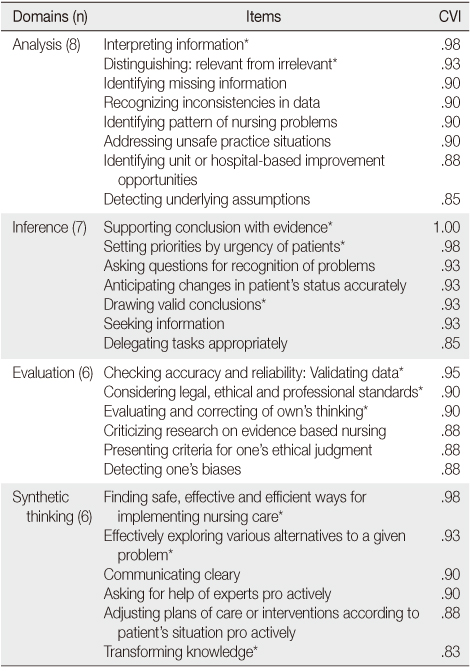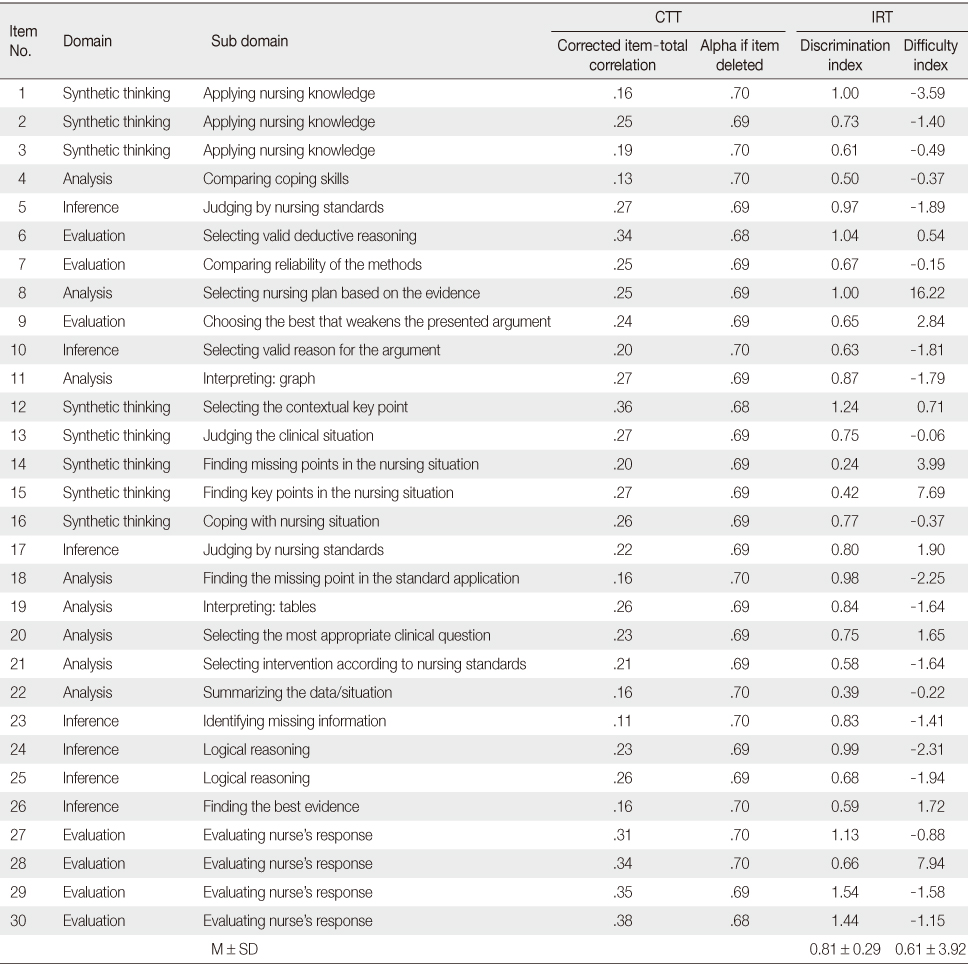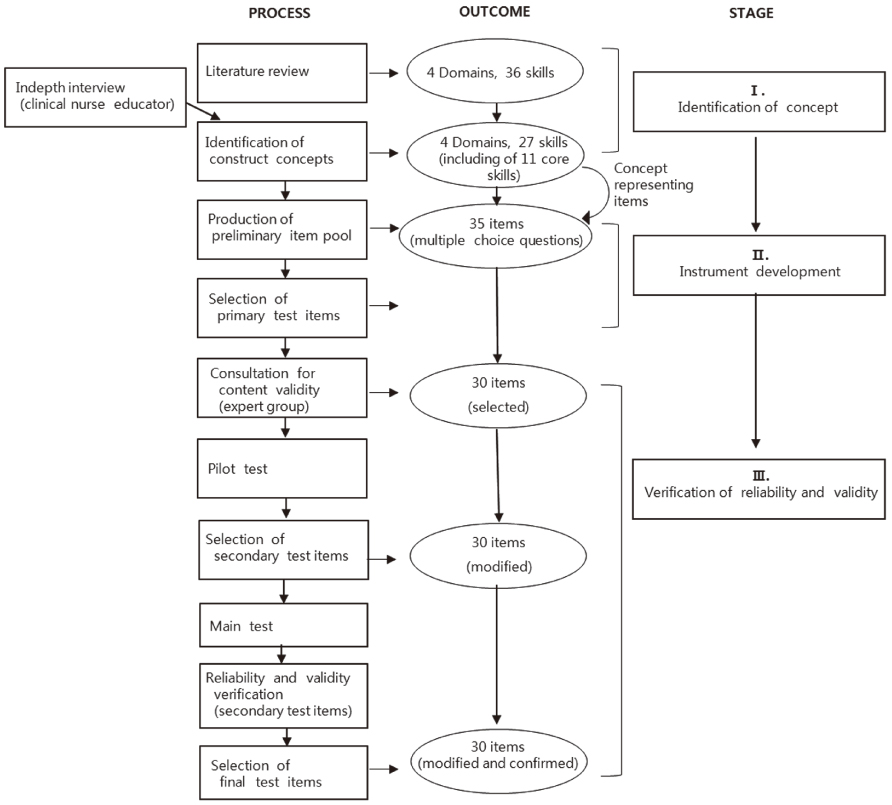Articles
- Page Path
- HOME > J Korean Acad Nurs > Volume 44(2); 2014 > Article
-
Original Article
- Development of Critical Thinking Skill Evaluation Scale for Nursing Students
- So Young You, Nam Cho Kim
-
Journal of Korean Academy of Nursing 2014;44(2):129-138.
DOI: https://doi.org/10.4040/jkan.2014.44.2.129
Published online: April 30, 2014
1Department of Nursing, Bucheon University, Bucheon, Korea.
2College of Nursing, The Catholic University of Korea, Seoul, Korea.
- Address reprint requests to: Kim, Nam Cho. College of Nursing, The Catholic University of Korea, 222 Banpo-daero, Seocho-gu, Seoul 137-701, Korea. Tel: +82-2-2258-7405, Fax: +82-2-2258-7772, kncpjo@catholic.ac.kr
© 2014 Korean Society of Nursing Science
This is an Open Access article distributed under the terms of the Creative Commons Attribution NoDerivs License. (http://creativecommons.org/licenses/by-nd/4.0/) If the original work is properly cited and retained without any modification or reproduction, it can be used and re-distributed in any format and medium.
Abstract
-
Purpose
- To develop a Critical Thinking Skill Test for Nursing Students.
-
Methods
- The construct concepts were drawn from a literature review and in-depth interviews with hospital nurses and surveys were conducted among students (n=607) from nursing colleges. The data were collected from September 13 to November 23, 2012 and analyzed using the SAS program, 9.2 version. The KR 20 coefficient for reliability, difficulty index, discrimination index, item-total correlation and known group technique for validity were performed.
-
Results
- Four domains and 27 skills were identified and 35 multiple choice items were developed. Thirty multiple choice items which had scores higher than .80 on the content validity index were selected for the pre test. From the analysis of the pre test data, a modified 30 items were selected for the main test. In the main test, the KR 20 coefficient was .70 and Corrected Item-Total Correlations range was .11-.38. There was a statistically significant difference between two academic systems (p=.001).
-
Conclusion
- The developed instrument is the first critical thinking skill test reflecting nursing perspectives in hospital settings and is expected to be utilized as a tool which contributes to improvement of the critical thinking ability of nursing students.
This manuscript is a condensed form of the first author's doctoral thesis from The Catholic University of Korea.
- 1. Brunt BA. Models, measurement, and strategies in developing critical-thinking skills. J Contin Educ Nurs. 2005;36(6):255–262.ArticlePubMed
- 2. Facione PA. Critical thinking: A statement of expert consensus for purposes of educational assessment and instruction. Executive summary, the Delphi report. Millbrae, CA: The California Academic Press; 1990.
- 3. Kim MS, Park C, Kim KS. Report No.: RRE 2001-6. A study for developing critical thinking test (I): Development of pilot test items. Seoul: Korea Institute for Curriculum and Evaluation; 2001.12.
- 4. Park JH. Study of abilities required to develop for student in nursing education. J Korean Acad Nurs Adm. 2011;17(1):74–87. http://dx.doi.org/10.11111/jkana.2011.17.1.74Article
- 5. Facione PA. Report No.: ERIC Document ED 327-549. The California critical thinking skills test: College level technical report 1: Experimental validation and content validity. Millbrae, CA: The California Academic Press; 1990.
- 6. Watson G, Glaser E. Watson-Glaser critical thinking appraisal. Cleveland, OH: The Psychological Corporation; 1980.
- 7. Giddens J, Gloeckner GW. The relationship of critical thinking to performance on the NCLEX-RN. J Nurs Educ. 2005;44(2):85–89.ArticlePubMed
- 8. Leppa CJ. Standardized measures of critical thinking. Experience with the California critical thinking tests. Nurse Educ. 1997;22(5):29–33.
- 9. Saucier BL, Stevens KR, Williams GB. Critical thinking outcomes of computer-assisted instruction versus written nursing process. Nurs Health Care Perspect. 2000;21(5):240–246.
- 10. Shin KR, Ha JY, Kim KH. A longitudinal study of critical thinking dispositions & critical thinking skills in baccalaureate nursing students. J Korean Acad Nurs. 2005;35(2):382–389.ArticlePDF
- 11. Thompson C, Rebeschi LM. Critical thinking skills of baccalaureate nursing students at program entry and exit. Nurs Health Care Perspect. 1999;20(5):248–252.PubMed
- 12. Lee YK, Kang JA. The demand and supply of regostered hospital nurses and policy recommendations. Seoul: Korean Institute of Hospital Management; 2008.
- 13. Yoon J. Development of an instrument for the measurement of critical thinking disposition : In nursing [dissertation]. Seoul, The Catholic University of Korea. 2004.
- 14. Son YJ, Song YA. Effects of simulation and problem-based learning courses on student critical thinking, problem solving abilities and learning. J Korean Acad Soc Nurs Educ. 2012;18(1):43–52. http://dx.doi.org/10.5977/jkasne.2012.18.1.043Article
- 15. Yang SH, Lee O, Lee WS, Yoon J, Park CS, Lee SJ. Critical disposition and clinical competency in 3 nursing colleges with different education methods. J Korean Acad Soc Nurs Educ. 2009;15(2):149–158. http://dx.doi.org/10.5977/JKASNE.2009.15.2.149Article
- 16. Ennis RH. A concept of critical thinking. Harv Educ Rev. 1962;32(1):81–111.
- 17. McPeck JE. Critical thinking and education. New York, NY: St. Martin's Press; 1981.
- 18. Paul RW. Dialogical thinking: Critical thought essential to the acquisition of rational knowledge and passions. In: Baron JB, Sternberg RJ, editors. Teaching thinking skills: Theory and practice. New York, NY: W. H. Freeman; 1987. p. 127–148.
- 19. Scheffer BK, Rubenfeld MG. A consensus statement on critical thinking in nursing. J Nurs Educ. 2000;39(8):352–359.ArticlePubMed
- 20. Berkow S, Virkstis K, Stewart J, Aronson S, Donohue M. Assessing individual frontline nurse critical thinking. J Nurs Adm. 2011;41(4):168–171. http://dx.doi.org/10.1097/NNA.0b013e3182118528ArticlePubMed
- 21. Alfaro-LeFevre R. Critical thinking in nursing: A practical approach. 2nd ed. Philadelphia, PA: W.B. Saunders; 1999.
- 22. Lee EO, Gu MO, Kwon IG, Kim KS, Kim IJ, Kim JI, et al. Research evaluation & utilization. Seoul: Koonja; 2007.
- 23. Morrison S, Nibert A, Fliack J. Critical thinking and test item writing. 2nd ed. Houston, TX: Health Education Systems, Inc; 2006.
- 24. Seong TJ. Modern educational evaluation. 3rd ed. Seoul: Hakjisa Publisher; 2010.
- 25. Lee JK. SAS and statistical data analysis. Seoul: Hakjisa Publisher; 2001.
- 26. Kim DH, Lee Y, Hwang MS, Park JH, Kim HS, Cha HG. Effects of a simulation-based integrated clinical practice program (SICPP) on the problem solving process, clinical competence and critical thinking in a nursing student. J Korean Acad Soc Nurs Educ. 2012;18(3):499–509. http://dx.doi.org/10.5977/jkasne.2012.18.3.499Article
- 27. Ham YL. Development and evaluation of a simulation educational program using a high-fidelity patient simulator for undergraduate nursing students [dissertation]. Seoul, Yonsei University. 2009.
- 28. Park DS. Technology for test-item writing. Seoul: Kyoyook book; 2000.
- 29. Facione PA, Facione NC, Blohm SW, Giancarlo CAF. The California critical thinking skills test (CCTS): Test manual 2002 updated edition. Millbrae, CA: The California Academic Press; 2002.
- 30. Kim MS. Factor construct and other psychometric characteristics of KICE critical thinking test as a complex higher-order thinking test. Korean J Educ Psychol. 2007;21(3):513–537.
REFERENCES


Figure & Data
REFERENCES
Citations

- Unveiling Critical Thinking Pedagogy: Classroom-Based Assessment Strategies in Higher Education
Nguyen Thi Thanh Tam, Tran Ngoc Tien
rEFLections.2024;[Epub] CrossRef - Chinese version of Yoon Critical Thinking Disposition Instrument: validation using classical test theory and Rasch analysis
Mio Leng Au, Yue Yi Li, Lai Kun Tong, Si Chen Wang, Wai I Ng
BMC Nursing.2023;[Epub] CrossRef - Influence of Perceived Helicopter Parenting, Critical Thinking Disposition, Cognitive Ability, and Learning Motivation on Learning Behavior among Nursing Students
Hyunjoo Oh, Haeryun Cho, So Youn Yim
International Journal of Environmental Research and Public Health.2021; 18(3): 1362. CrossRef - A Review for Concept Clarification of Critical Thinking, Clinical Reasoning, and Clinical Judgment in Nursing Education
Dongsuk Lee, Jiyeon Park
Journal of Korean Academic Society of Nursing Education.2019; 25(3): 378. CrossRef - Effect of a Situational Module Learning Course on Critical Thinking Disposition and Metacognition in Nursing Students: A Quasi-experimental Study
Kwang Ok Park, Mi Yu
Journal of Korean Academic Society of Nursing Education.2019; 25(2): 251. CrossRef - Referenciais teóricos e instrumentos para avaliação do pensamento crítico na enfermagem e na educação
Fernando Riegel, Maria da Graça Oliveira Crossetti
Revista Gaúcha de Enfermagem.2018;[Epub] CrossRef - Changes in decision‐making among Italian nurses and nursing students over the last 15 years
Cristina Canova, Giorgio Brogiato, Gabriele Roveron, Renzo Zanotti
Journal of Clinical Nursing.2016; 25(5-6): 811. CrossRef - A literature Review (1996-2014) on Critical Thinking in Korean Nursing Education for the Era of Convergence
Na-Sun Ha, So-Young Pak, Mi-Ja Lee
Journal of Digital Convergence.2015; 13(9): 341. CrossRef - A Study on application Course Embedded Assessment(CEA) for Program Outcome Assessment in Nursing Education
Soung-Mi Nam
Journal of the Korea Academia-Industrial cooperation Society.2015; 16(5): 3121. CrossRef - Validation of Yoon's Critical Thinking Disposition Instrument
Hyunsook Shin, Chang Gi Park, Hyojin Kim
Asian Nursing Research.2015; 9(4): 342. CrossRef

Figure 1
List of Critical Thinking Skills from Literature Review and Interviews with Clinical Practitioners
*Best represents of each domain; CVI=Content Validity Index.
Item-Total Correlation and Discrimination and Difficulty Indices using Item Response Theory of the Main Test Tool
CTT=Classic test theory; IRT=Item response theory.
Differences of Main Test Scores by Academic System: For a Course in Philosophy, and for a Course in PBL or Simulation (N=307)
PBL=Problem based learning.
Kuder-Richardson 20 Coefficient of the Main Test Tool
*Best represents of each domain; CVI=Content Validity Index.
CTT=Classic test theory; IRT=Item response theory.
PBL=Problem based learning.
 KSNS
KSNS
 E-SUBMISSION
E-SUBMISSION



 Cite
Cite

